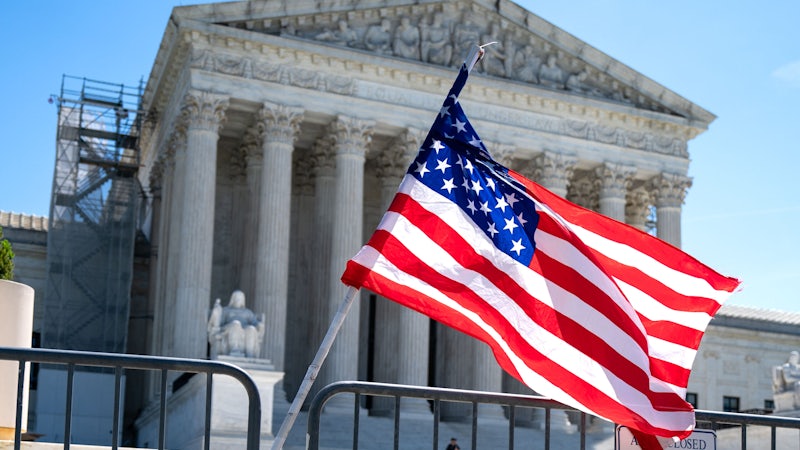Dear Reader,
A couple of weeks ago, I spent two days in Tulsa, Oklahoma and had a chance to visit the Greenwood District, home of “Black Wall Street” and the 1921 Tulsa Race Massacre. It was a sobering visit, and my subsequent further reading about that event revealed details I had not known or ever learned in school. This knowledge, though, was a useful backdrop against which to read the Justice Department’s indictment against two Americans, Dallas Humber and Matthew Allison, who ran a white supremacist terrorist recruitment platform called the “Terrorgram Collective.” When viewed in this historical perspective, the Terrorgram indictment offers some good news and bad news about where we are today in terms of combating racially-motivated violence compared to a century ago.
“Terrorgram,” as it was known by its participants (a super creative amalgamation of “terror” and “Telegram,” the social media platform the defendants utilized) promoted white supremacist “accelerationism.” The indictment describes this ideology as one “centered on the belief that the white race is superior; that society is irreparably corrupt and cannot be saved by political action; and that violence and terrorism is necessary to ignite a race war and ‘accelerate’ the collapse of the government and the rise of a white ethnostate.” (For more on the narrative structure of white nationalist ideology compared to other terrorist ideologies, including the Big Lie about the 2020 election, see my June 2021 Note.) Terrorgram recruited people to commit violence on behalf of the white race, provided lists of targets (including U.S. officials and critical infrastructure) and how-to manuals for making bombs, and offered a path to “sainthood” for anyone who was martyred in their cause. Humber and Allison’s efforts were successful: The indictment links Terrorgram to racially motivated attacks in New Jersey, Slovakia, and Turkey.
So let’s start with the good news. The most notable part of the Justice Department’s charges is that it treats Terrorgram as a “transnational terrorist group.” This is a departure from the way that prosecutors have historically addressed acts of white supremacist violence in the U.S., which have typically been characterized as one-off, “lone wolf” attacks (think Timothy McVeigh, or Dylann Roof). By reframing Terrorgram as an ideological movement linked to disparate acts of violence around the world, the Justice Department is treating white supremacist violence similarly to the way that it has treated Islamic terrorism since 9/11—namely, that seemingly unrelated acts of violence should be seen as interconnected if they are inspired by a common ideology and purpose. This paradigm shift is important, because it can open up powerful legal tools—like laws that prohibit material support to terrorism—that can disrupt and dismantle these kinds of networks. It also opens the door for U.S. law enforcement to work closely with foreign allies who are seeing a similar rise of white nationalist violence in their countries.
And now the bad news. To go back to Oklahoma’s history, it will probably not surprise you to know that Tulsa, like many cities across the nation in the 1920s, was a hotbed of activity for the Ku Klux Klan. (And not just in the South; don’t forget that Donald Trump’s father, Fred Trump Jr. was arrested at a violent Klan rally in Jamaica, Queens in 1927.) What’s interesting is that the Klan was formed by Confederate soldiers in the immediate aftermath of the Civil War, reining terror in Black communities across the South. But President Ulysses S. Grant, who obviously had no time for a reprise of Southern racist shenanigans, passed the Ku Klux Klan Acts of 1870 and 1871—the same acts, incidentally, underlying one of the charges against Trump and several of the civil actions against January 6 rioters—which more or less quickly nipped the Klan in the bud. That is, until 1915, when a white supremacist filmmaker named D.W. Griffith produced a silent film called Birth of a Nation, depicting the grave threat to “law and order” that Blacks posed to white America. Birth of a Nation was screened to critical acclaim all across the country (including in the basement of the White House to then-President Woodrow Wilson) and within just a few years, the KKK—which rebranded itself as a “fraternal order”—had swelled to over one million members. This time the federal government didn’t do anything to try to squash it.
In other words, what facilitated the resurgence of organized racial violence in the early twentieth century was mass propaganda enabled by communications technology—at that time, film. And on this front, the information landscape has only gotten more dangerous. In my last Note about the French police’s arrest of Telegram’s founder, Pavel Durov, I explained how Telegram offers unique features that make it especially attractive to criminals and terrorists because of its reach, speed, and almost complete lack of any content moderation. It also combines a number of different mass communication features, like broadcast channels, group chats, and encrypted direct messaging. Terrorgram’s founders utilized these features to full effect, producing a 24-minute documentary on its channel that celebrated all of the acts of white supremacist violence that took place between 1968 and 2001 and distributed publications in audiobook form. Unlike the “local” KKK chapters of the past which were constrained by geography, Humber and Allison were also able to directly communicate with prospective terrorists all around the globe, “coaching” and even livestreaming attempted terrorist attacks in places like France and Australia.
Perhaps the most disheartening aspect of the Terrorgram indictment is what it reveals about the audience and demand for this content. The rise of white supremacist ideology globally illustrates that we have not made the progress we have needed to over the last century to effectively combat racially-motivated extremism, partly because there are too many people who sympathize with it—groups like the Terrorgram Collective provide the same sense of kinship and solidarity as the Klan of the 1920s. While the Terrorgram indictment offers hope that our justice system may finally be capable of confronting this threat at a larger scale, social media has the potential to outpace these efforts by increasingly recruiting adherents to the cause. As we approach one of the most critical elections of our lifetimes, it’s worth asking which candidate is likely to both continue the Justice Department’s aggressive posture, and perhaps take on social media platforms, to stop the long arc of racial violence.
Stay Informed,
Asha





























